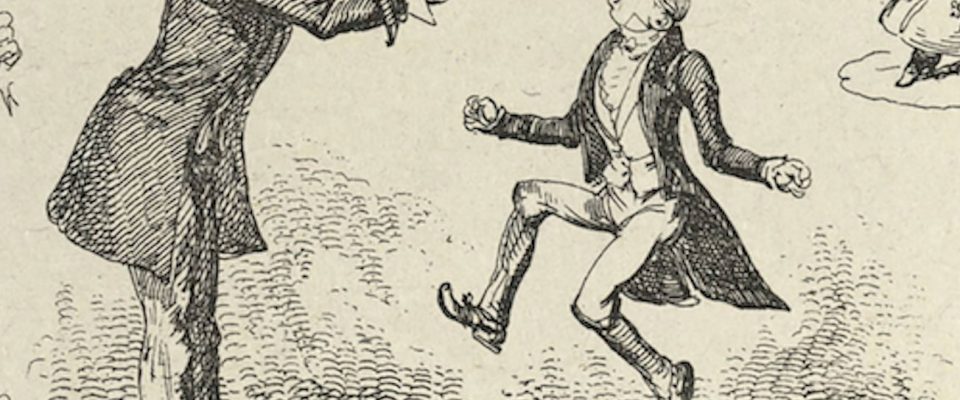By Faezeh Pasandi
You’ve probably seen many caricatures during your life and most definitely you‘ve said, “this is hilarious!” But how did this visual form enter the popular culture of Britain? It was in the 16th century that Annibale Carracci in Italy started making mock portraits. Later on, in the 18th century William Hogarth created very appealing satiristic portraits. In the 19th century James Gillray, Thomas Rowlandson, and George Cruikshank’s graphic satire became popular.
The word “caricature” derives from the Italian “caricare” which means “surcharge” or “overload.” Caricatures are created for humor to make a point about politics or human behavior. George Cruikshank, the well-known 19th century illustrator created many caricatures for making people aware of politics or criticizing human behavior as well as impressing people with his art. Here, we will see a specific example of nose surcharge in George Cruikshank caricature.
Body Features in Caricature
The science of analyzing a human personality, feeling, mind by interpreting physical appearances is called “physiognomics.” Many physiognomists took gesture and face expression into account. William Hogarth (1697-1726) was one of the pioneers of this style and had a great influence on later caricaturists.George Cruikshank was no exception. Hogarth organized and honed the aesthetic of physiognomy in his graphic works. Instead of just mocking his subjects, Hogarth tried to expose their true nature.
George Cruikshank also shows the feeling and mind of his characters/his own feelings toward the characters especially through their facial features. He emphasizes the noses as the main element of his characters. In the illustration “Fagin in the condemned cell” (1839) in Oliver Twist by Charles Dicken, Fagin has a huge nose, matted hair, and an odd appearance. Another example of a large nose in illustration by George Cruikshank is “The Long-nosed Stranger at Strasburg” for Laurence Sterne’s Tristram Shandy (1766).
Still today, it is common to see caricatures, where characters have distorted, exaggerated noses. The nose can be an obnoxious feature of the body as it sits in the center of the face, a vertical feature in the face in comparison with eyes and mouth. Maybe these natural features of the nose were an obvious area for George Cruikshank to focus on; another assumption is that George Cruikshank wanted to have his own distinct style.
The chapter of Noses an Etching by George Cruikshank
To know more about what noses represent in George Cruikshank’s art I have chosen an etching from “My Sketchbook”(1834-36) from the George Cruikshank collection at UMBC’s Albin O. Kuhn Library. In this sketch there are seven portraits and a text under them that gives us some information about the context.
The text says “most approved method of pulling a fellows nose” and talks about Mr Kidd, who seems to be a friend of George Cruikshank’s mentioned in the text. In the center of the etching we see that George Cruikshank is pulling Kidd’s nose with tongs. Here, George Cruikshank is giant and Kidd is small. George Cruikshank is irritated by Kidd and is punishing him. The story behind it is that Kidd publishes wood engravings from George Cruikshank with only the name “Cruikshank.” So George Cruikshank uses his caricature as a weapon to ridicule him.
On top of the picture, there are several persons with different types of noses showing the artist’s ability in drawing different characters. Other portraits are mostly representing the artist’s fantasy of punishment by noses. In the right corner, St. Dunstan is pulling a monster/evil nose and fighting him. In the left corner, the two portraits picture a man that has a large pointed down nose and a dog is biting it while the man is trying to hit him. The other character is pulled by a hand from his nose. It is very interesting to see how humans could fight or punish each other only by their nose.
Two different portraits do not display any punishment. One of these is behind George Cruikshank’s self portrait. The character is just touching his nose while blinking at us. The blinking and the placement of the index finger show his complicity with the viewer.
The portrait of noses is not only about making fun of others. Sometimes, it shows physical desire. The other portrait shows a male and a female dwarf. The man has a giant long nose while the woman has a smaller, more elegant nose. The man and the woman are giving each other flowers and the woman says, “Take this rosegay gentle youth”; the man says, “And you sweet maid, take mine.” This representation of nose shows some sexual desires here. The man has a bigger one so it means the man’s sexual desires are higher than the woman’s.
Overall, the caricature is a way to show an artist’s creative fantasies in their mind. If you would like to see more of George Cruickshank’s creative mind and artistic hand, visit the UMBC library.


 Albin O. Kuhn Library & Gallery
Albin O. Kuhn Library & Gallery